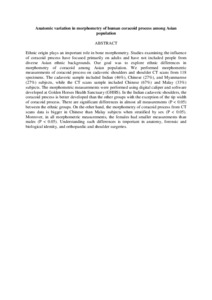Citation
Fathi, Manal and Cheah, Pike See and Ahmad, Umar and Mohd Nasir, Mohd Nizlan and San, Aye Aye and Abdul Rahim, Ezamin and Hussin, Paisal and Mahmud, Rozi and Othman, Fauziah
(2017)
Anatomic variation in morphometry of human coracoid process among Asian population.
BioMed Research International.
art. no. 6307019.
pp. 1-10.
ISSN 2314-6133; ESSN: 2314-6141
Abstract
Ethnic origin plays an important role in bone morphometry. Studies examining the influence of coracoid process have focused primarily on adults and have not included people from diverse Asian ethnic backgrounds. Our goal was to explore ethnic differences in morphometry of coracoid among Asian population. We performed morphometric measurements of coracoid process on cadaveric shoulders and shoulder CT scans from 118 specimens. The cadaveric sample included Indian (46%), Chinese (27%), and Myanmarese (27%) subjects, while the CT scans sample included Chinese (67%) and Malay (33%) subjects. The morphometric measurements were performed using digital caliper and software developed at Golden Horses Health Sanctuary (GHHS). In the Indian cadaveric shoulders, the coracoid process is better developed than the other groups with the exception of the tip width of coracoid process. There are significant differences in almost all measurements (P < 0.05) between the ethnic groups. On the other hand, the morphometry of coracoid process from CT scans data is bigger in Chinese than Malay subjects when stratified by sex (P < 0.05). Moreover, in all morphometric measurements, the females had smaller measurements than males (P < 0.05). Understanding such differences is important in anatomy, forensic and biological identity, and orthopaedic and shoulder surgeries.
Download File
![[img]](http://psasir.upm.edu.my/60863/1.hassmallThumbnailVersion/Anatomic%20variation%20in%20morphometry%20of%20human%20coracoid%20process%20among%20Asian%20population.pdf)  Preview |
|
Text (Abstract)
Anatomic variation in morphometry of human coracoid process among Asian population.pdf
Download (5kB)
| Preview
|
|
Additional Metadata
Actions (login required)
 |
View Item |

